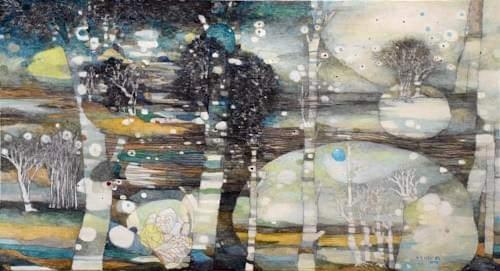
山水系列之繁影靜生1 限量數位典藏版 No.1~15 / 15
NT$3,200
這不再是傳統的山水描摹,
而是記憶與時間交織後,光影留下的斑駁紋理。
《繁影靜生1》是藝術家 Kuo Yu HSU 許國鈺對風景意象的轉化與深刻凝視。
作品中層層堆疊的光影與色彩,如同潛意識中記憶與情感交錯的軌跡。
此次特別推出數位典藏版本,全球限量15份,
附藝術圖卡與正式授權書,邀您收藏一幅靜謐且富有生命力的心靈風景。
💾 商品內容:
高解析數位圖檔(JPG,2554x 4709 px,300dpi)
授權列印最大尺寸:39.9 x 21.6 公分,相當約 A3 略小一點(A3 是 42 x 29.7 公分)
附藝術圖卡一張(作品介紹+限量編號)
附數位授權書(含限量編號與藝術家簽名)
限量15份,每份附限量編號(如 KHSU-FYJS-01/15),永久授權單次列印收藏。
建議採用5760dpi高解析度,250g/m²以上彩色相片紙列印,高品質彩色印表機列印,即可呈現最佳細節層次。
請勿使用一般彩色影印,效果極差。
向左滑動即可查看其數位簽名。
🔖 收藏推薦:
你嚮往穿越光影與記憶間的抽象旅程
喜歡結合詩意與秩序的藝術語言
希望收藏藝術家親簽認證的限量數位典藏作品
下單成功後會看到下載鏈接(鏈接有效期 72 小時),同時會收到一封附加下載鏈接的確認郵件。
下載完成後,我們將以電子郵件寄送藝術圖卡與授權書。

山水系列-繁影靜生1 66x120cm 布面油畫 2018年 (藝術銀行收藏)
《繁影靜生1》創作理念
《繁影靜生1》作為山水系列中的一環,旨在探討風景作為一種視覺與心理經驗的複合體。作品通過多層次的光影交錯與色彩疊加,呈現出一種非線性、碎片化的時間感,呼應當代對於時間與空間理解的重構。此種非傳統的風景呈現,不僅挑戰了西方經典透視法與中國傳統山水畫的「空間詩學」(spatial poetics),同時也與現象學中「知覺即經驗」的理念形成對話,強調觀看本身即為一種主體性的生成。
從現象學視角來看,莫里斯·梅洛-龐蒂(Maurice Merleau-Ponty)提出身體與世界的互動中,知覺不是被動的接收,而是身體與環境之間動態的共生關係。作品中的繁複影像象徵了這種共生過程中感知的多層次與多維度。透過畫面中重複且錯落的視覺片段,觀者的目光被引導進入一個非連續的視覺場域,在斷裂與重構間,重新理解風景的流動本質。
此外,作品在色彩與光影的變化上,呼應了巴特勒(Judith Butler)關於「身份的建構性」(constructivism)理論,暗示個體經驗並非固態,而是在時間與環境互動中不斷生成與變動。這種生成過程反映於畫面中的層疊與模糊,使得「繁影」不僅是自然現象的映射,更是身份與記憶的投射。
從視覺文化的角度,碎片化與多視角呈現與後現代主義對「整體敘事」的解構相呼應。作品不追求統一的敘述,而是以開放的結構邀請觀者參與主體性的建構。這種觀看行為本身,成為作品意義的生成場域。觀者在視覺斷裂與重組中體驗時間的多重性,進而反思自身與環境的關係。
創作過程中,筆觸的疊加與細膩變化不僅是技術手法,更是對「時間性物質」(temporal materiality)的實踐。作品捕捉了瞬間與永恆之間的張力,映照出記憶中風景的流動性與不確定性。這一點與當代繪畫理論中強調「繪畫作為時間載體」的觀點相契合,畫布成為時間累積與情感沉澱的空間。
在保留詩意的同時,作品並未刻意訴諸宗教或形而上學的解讀,而是透過純粹的視覺經驗與感知細節,傳達一種在現代社會中對靜謐與生命力的追尋。這種追尋,既是個人內心的安頓,也是對外在世界流變的敏銳覺察。
總體而言,《繁影靜生1》融合了當代哲學、視覺文化與繪畫技法,呈現一幅在碎片化時代中尋求整合的風景畫。它不僅是對自然的凝視,更是對人類感知與存在狀態的深刻反思。作品邀請觀者在繁複光影中體驗時空的多層次,並在靜謐中感受生命的持續流動與生成。
Creative Statement of Echoes of Stillness 1
As part of the Landscapes Series, Echoes of Stillness 1 explores landscape as a complex interplay between visual and psychological experience. Through multilayered interplays of light and shadow and overlapping color planes, the work conveys a nonlinear, fragmented sense of time that resonates with contemporary reconceptualizations of temporality and spatiality. This nontraditional depiction of landscape challenges both Western classical perspective and the “spatial poetics” of traditional Chinese landscape painting, while engaging in dialogue with phenomenological notions of “perception as experience,” emphasizing viewing itself as an act of subject formation.
From a phenomenological perspective, Maurice Merleau-Ponty’s concept of perception as an active, embodied engagement with the world is central. The intricate imagery symbolizes the multilayered and multidimensional nature of such embodied perception. Through repetitive and staggered visual fragments, the viewer’s gaze is drawn into a discontinuous visual field where fragmentation and reconstruction invite a renewed understanding of landscape as a dynamic flow.
Moreover, the work’s modulation of color and light gestures toward Judith Butler’s theory of “identity as constructed,” suggesting that individual experience is not fixed but continuously generated and transformed through interactions with time and environment. This process of becoming is reflected in the painting’s layered and blurred forms, making the “echoes of stillness” both a reflection of natural phenomena and a projection of identity and memory.
From the perspective of visual culture, the fragmentation and multiplicity of perspectives correspond to postmodern critiques of grand narratives. The work eschews unified storytelling, opting instead for an open structure that invites active viewer participation in meaning-making. The act of viewing becomes the generative space of the work’s significance. Within the visual ruptures and recompositions, viewers experience temporal multiplicity and are invited to reconsider their relationship to the environment.
Technically, the layering of brushstrokes and subtle gradations are not only methods but enactments of “temporal materiality.” The painting captures the tension between the momentary and the eternal, reflecting the fluidity and uncertainty of remembered landscapes. This aligns with contemporary painting theories that emphasize painting as a vessel of time—where the canvas becomes a space for accumulation of time and emotional sediment.
While maintaining poetic sensibility, the work intentionally avoids explicit religious or metaphysical references. Instead, it conveys a pursuit of stillness and vitality in modern life through pure visual experience and perceptual nuance. This pursuit serves both as personal interior anchoring and as acute awareness of the flux of the external world.
In sum, Echoes of Stillness 1 integrates contemporary philosophy, visual culture, and painterly technique to present a landscape painting that seeks cohesion amidst fragmentation characteristic of our era. It is not only a contemplation of nature but also a profound reflection on human perception and modes of existence. The work invites viewers to inhabit the multilayered temporality embedded in its complex light and shadow, sensing within stillness the ongoing flow and becoming of life.



